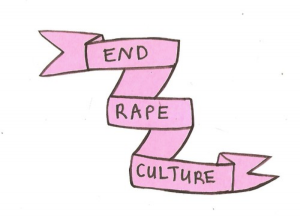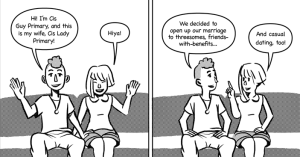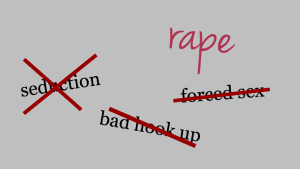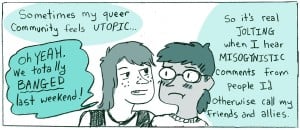
Source: Our Femifesto
At first glance, we associate rape culture with sexual violence.
Dig a little deeper, and we see the enabling and creation of victim blaming, stigma, and silence.
But as with all other systems of oppression, rape culture is a beast with tentacles and spores across countless other facets of inequality and systems of oppression.
This is why dismantling rape culture must happen from as many different angles as possible in order to be effective. We need an intersectional and inclusive approach to upsetting the culture of rape and building a culture of consent.
The following three things may not appear to be major components of rape culture at first glance, but undoubtedly fuel and are fueled by it.
Dismantling and addressing these things must be part of our movement to end rape culture.
1. Gender Norms
Traditional gender roles and norms sustain inequality, and rape culture thrives on inequality.
Rigid gender norms based in the gender binary and normative expectations of how people should carry themselves through the world restrict the space we have for authentic expression and communication.
The extremely limited range of emotions, thoughts, and actions we’re taught we can have based on our gender can in many ways predetermine the conversations — or lack thereof — that we have about sex and consent.
For example, the social script we’re taught to engage in when it comes to sex casts a cisgender man and woman — effectively erasing queer sex and genders that fall outside or between this limited binary — and prescribes starkly different roles for each of them.
This social script we learn growing up and continue to see played out around us typically features a coy, demure, and sexy (but not slutty!) woman, waiting to be romanced/dominated by a strong, confident, and aggressive man.
Consent is assumed, never discussed. Man orgasms. Sex over. Not a great platform from which to learn and practice consent.
This is just one way that gender norms fuel rape culture.
When gender norms create the social DNA of strong, confident, and aggressive men as the opposite of coy, demure, and sexy women, popular narratives emerge around any and all sorts of experiences, including sexual violence.
The way normative masculinity is structured and performed allows for very little — if any — room for men to claim the identity of being a survivor of rape or sexual abuse.
One in six men is a survivor of childhood sexual abuse and one in 33 men is a survivor of rape, but toxic masculinity silences and stigmatizes these stories and experiences because they don’t match neatly with the strong, confident, and aggressive man typecast by gender norms.
While toxic masculinity works to silence the experiences that men have with sexual violence, it simultaneously silences women’s experiences with sexual violence by creating myths around what constitutes consent.
These myths ultimately undermine the way we (fail to) listen to and (do not) believe women’s stories related to rape and abuse.
Some common examples include someone’s outfit being interpreted as “asking for it,” flirting being conflated with consent to have sex, and reporting rape being interpreted as regret for being “slutty.”
These myths, rooted in the traditional understanding of femininity, effectively rob women of their agency before, during, and after rape by always circling blame back onto them and constructing femininity as something inherently “asking for it.”
Another layer we must consider is that the gender binary itself restricts the way we — including advocates and activists — talk about sexual violence and rape culture.
In many ways, the binary makes the experiences of transgender and gender non-conforming people with sexual violence invisible.
While someone in the trans* community is five times more likely to survive sexual assault than a cisgender woman and 21 times more likely than a cisgender man, the trans* community is almost never centered in conversations or campaigns about rape culture.
And if we want to dismantle rape culture, we have to do so from all angles, not just those made accessible to us through the gender binary.
2. Language and Accessibility
In order for the consent movement to overcome rape culture, we have to make our movement accessible to the people who have never even heard of rape culture.
Luckily everyone knows rape culture at some level. We just have to let different communities create and define their own language around sexual violence, as Sesali Bowen explained at FORCE: Upsetting Rape Culture’s panel discussion last month.
We can’t just preach to the choir. That won’t get us very far. For example, the consent is sexy message isn’t culturally relevant or resonant in all communities.
It’s easy to forget what the majority of people don’t know about sexual violence if we’re well-versed in the ins and outs of rape culture. But we have to make an effort to be nice and welcoming to beginners.
This piece of accessibility also requires patience and faith in the fact that even the most unlikely folks can see the light.
3. The Prison Industrial Complex
It is relatively well-known that police and the criminal “justice” system consistently fail survivors. One of the reasons we consider this to be the case is because only 3% of rapists will ever spend a day in prison.
Missing from this analysis of justice is the fact that prison and the prison industrial complex only perpetuate rape culture.
American prisons are institutions of violence, rooted deeply in racism. One in every ten people in prison will experience sexual abuse while incarcerated, commonly at the hands of prison staff.
How can a system of violence and racism be the answer to sexual violence?
It can’t be — and that’s why the movement to end rape culture must reconcile itself with the reality of the prison system.
In various ways, the prison system and its various appendages perpetuate rape culture.
Stop and frisk laws often enable legally sanctioned sexual violence that is fueled by prejudice and racial profiling.
In no way do I intend to criticize survivors whose reports of rape ended in their perpetrator going to prison — or the many survivors that wish that to be the case for their rapists.
Incarceration is the only model we currently have for survivors to seek justice and because of this, on a micro level, it is a valid form of justice that we so desperately seek.
Intersectionality allows us to see that at the macro, systematic level, the criminal justice system as it exists today cannot possibly serve the interests and goals of the movement to end rape culture.
***
It can be daunting to think that ending rape culture hinges upon dismantling several other norms and systems of oppression, but I find comfort in reminding myself that the only thing bigger than what our movement has to address and dismantle is the need for us to do so.
[ultimatesocial_facebook custom_class=”fb-btn-us”] [ultimatesocial_twitter custom_class=”tw-btn-us”]
Want to discuss this further? Login to our online forum and start a post! If you’re not already registered as a forum user, please register first here.
Sara Alcid is a Contributing Writer for Everyday Feminism and is a young feminist living and working in Washington, DC as a reproductive health and justice advocate. Sara loves thinking, reading and writing about the socially and personally transformative power of feminism, queer issues, and women’s health. Follow her on Twitter @SaraAlcid. Read her articles here and book her for speaking engagements here.
Search our 3000+ articles!
Read our articles about:
Our online racial justice training
Used by hundreds of universities, non-profits, and businesses.
Click to learn more
Most Read Articles
- « Previous
- 1
- …
- 30
- 31
- 32



















